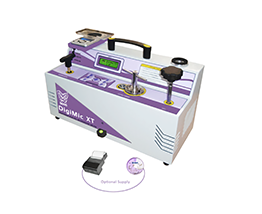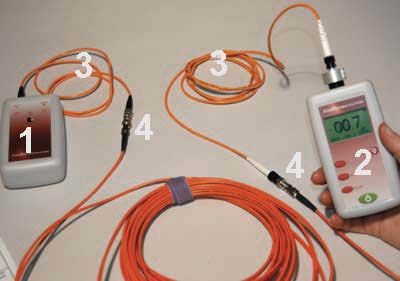Emerging innovations in robotic vision for factories
Wiki Article
Understanding Just How an Optical Measurement System Boosts Accuracy in Industrial Applications
Optical measurement systems play an essential duty in boosting precision across numerous industrial applications. By leveraging innovative modern technologies such as laser interferometry and 3D imaging sensors, these systems use high-resolution, non-contact dimensions. This capacity decreases the threat of damaging delicate parts while guaranteeing precision. Nonetheless, the influence of these systems expands beyond simple dimensions. Exploring their advantages, applications, and future fads reveals a complex landscape of technology and difficulties that qualities closer examination.The Fundamentals of Optical Measurement Systems
Optical measurement systems function as essential tools in numerous commercial applications, supplying specific data collection and evaluation. These systems use light as a main means of measurement, leveraging optical principles to assess measurements, settings, and surface qualities of objects. They integrate components such as lasers, electronic cameras, and sensing units, which collaborate to record high-resolution pictures and data.The innovation makes it possible for non-contact measurements, reducing the danger of damaging sensitive parts. Optical measurement systems are functional, discovering energy in top quality control, assembly confirmation, and dimensional analysis throughout different sectors. They are particularly efficient in settings where conventional measurement techniques may drop short, such as gauging complex geometries or observing fast movements.
As industries proceed to progress, the integration of optical measurement systems will certainly remain crucial for ensuring precision and effectiveness, eventually enhancing product high quality and functional productivity in various making processes.
Secret Technologies Behind Optical Measurement
Trick innovations such as laser interferometry strategies and 3D imaging sensors play an important function in the effectiveness of optical measurement systems (fibre testing equipment). These technologies enable precise dimensions and comprehensive analysis in various industrial applications. Recognizing their functionalities is important for taking advantage of the full possibility of optical measurement systemsLaser Interferometry Techniques
Countless laser interferometry methods have reinvented the field of optical measurement, offering extraordinary precision and accuracy in numerous commercial applications. These methods use the interference of coherent light waves to measure range, displacement, and surface area abnormalities with nanometer-level accuracy. Usual methods include Michelson interferometry, which splits a beam of light and analyzes stage shifts, and Fabry-Pérot interferometry, known for its high resolution in determining small modifications. Furthermore, laser Doppler interferometry utilizes regularity changes to evaluate rate, making it invaluable in vibrant dimensions. The adaptability of these methods permits their assimilation into diverse production processes, enhancing quality assurance and guaranteeing adherence to rigid resistances. Therefore, laser interferometry remains to play a crucial function in advancing commercial measurement requirements.3D Imaging Sensors
Advancements in measurement innovation have brought about the growth of 3D imaging sensing units, which play a considerable function in optical measurement systems. These sensing units catch three-dimensional data with different methods such as triangulation, time-of-flight, and structured light. By properly rebuilding the shape and dimensions of objects, 3D imaging sensors enhance the accuracy of measurements in industrial applications. They give real-time feedback, assisting in quality assurance and ensuring that components meet rigid specifications. Furthermore, their capacity to operate in difficult atmospheres, such as differing lights problems, makes them important in making processes. As sectors increasingly embrace automation, the assimilation of 3D imaging sensing units right into optical measurement systems is anticipated to drive additional enhancements in efficiency and accuracy.Benefits of Optical Measurement in Industry
Traditional measurement methods have actually long been the criterion in industrial setups, optical measurement systems supply significant benefits that enhance precision and effectiveness. These systems make use of light to record data, causing high-resolution dimensions that are typically unattainable with standard methods. The non-contact nature of optical measurements decreases the risk of damaging sensitive parts throughout the analysis procedure. Furthermore, the speed of optical measurements enables quick information acquisition, assisting in timely decision-making in hectic commercial settings.Optical systems are versatile, efficient in determining various materials and shapes without the demand for extensive recalibration. This adaptability adds to improved process and efficiency. Additionally, the automation potential of optical measurement systems decreases human error, guaranteeing constant quality assurance. On the whole, the combination of optical measurement innovation represents a progressive change in the direction of enhanced accuracy and dependability in commercial procedures, ultimately bring about enhanced product top quality and operational effectiveness.
Applications of Optical Measurement Systems

Optical measurement systems play an essential function in boosting manufacturing process optimization by supplying exact data for decision-making. These systems guarantee quality assurance assurance via real-time tracking and evaluation of manufacturing metrics. As markets significantly adopt these innovations, their effect on performance and product reliability ends have a peek here up being obvious.
Production Process Optimization
Enhancing manufacturing procedure efficiency is increasingly reliant on the combination of optical measurement systems. These systems supply real-time information on numerous criteria, permitting suppliers to analyze procedures with a high level of accuracy. By allowing specific measurements of dimensions, surface attributes, and material residential properties, optical measurement systems assist in the identification of inefficiencies and bottlenecks in assembly line. The immediate feedback from these systems encourages engineers to make informed choices, resulting in maximized machining, assembly, and finishing procedures. The capability to keep an eye on problems constantly allows for adaptive changes, minimizing downtime and waste. As industries goal for greater performance and decreased operational costs, optical measurement systems arise as important devices for improving manufacturing procedure optimization.
Quality Control Guarantee
The combination of optical measurement systems greatly impacts high quality control assurance in industrial setups. These systems give specific and non-destructive dimensions, allowing suppliers to discover defects and discrepancies early in the manufacturing process. By making use of sophisticated imaging strategies, such as laser triangulation and interferometry, optical measurement systems ensure that parts satisfy strict specifications. This assists in real-time tracking, decreasing waste and reducing the threat of defective products getting to the marketplace. Furthermore, the information accumulated can be assessed to improve production processes even more, leading to constant enhancement. Eventually, the adoption of optical measurement systems improves dependability and consistency in quality control, cultivating higher self-confidence amongst stakeholders and consumers alike in the last items provided.Case Studies: Successful Executions
Many industries have actually efficiently integrated optical measurement systems to boost their functional performance and item quality. As an example, in the automotive field, a prominent supplier adopted a laser triangulation system to check the placement of lorry elements. This execution substantially lowered setting up errors, leading to boosted security and minimized expenses.In the aerospace sector, a leading airplane maker utilized optical assessment for precision dimensions of turbine blades, achieving a decrease in making tolerances and far better efficiency requirements.
In a similar way, a customer electronics business executed optical measurement innovation during the production of smartphone screens, causing enhanced high quality control and a decrease in defective products.
These study illustrate exactly how optical measurement systems not only improve accuracy however additionally add to total operational efficiency, showing their value throughout different industries. By addressing details demands, these systems you could check here have actually verified to be vital devices in modern-day industrial applications.
Difficulties and Limitations of Optical Measurement
While optical measurement systems supply significant advantages in various commercial applications, they are not without their challenges and restrictions. One significant problem is level of sensitivity to ecological conditions, such as temperature changes, moisture, and dirt, which can adversely influence measurement accuracy. Furthermore, optical systems often need exact alignment and calibration, making them vulnerable to human error during configuration and procedure. An additional constraint is the possibility for interference from ambient light, which can misshape measurements and demand complicated filtering techniques. Particular products and surfaces might provide troubles, as reflective or transparent features can lead to irregular analyses. The expense of high-quality optical components and systems can also be a barrier for some industries, restricting prevalent fostering. Specialized training is typically needed for personnel to properly run and keep these systems, adding to the overall intricacy and functional obstacles.Future Fads in Optical Measurement Technology
As developments in modern technology proceed to shape commercial procedures, the future of optical measurement systems is positioned for substantial advancement. Arising patterns indicate a shift in the direction of improved integration of expert system and artificial intelligence, making it possible for systems to assess information in real-time, recognize patterns, and boost decision-making processes. Furthermore, the development of miniaturized sensing units and progressed optics is anticipated to result in even more compact and versatile measurement remedies, making them obtainable for a larger variety of applications.In addition, the consolidation of 3D imaging and high-resolution abilities will enable unmatched accuracy in measurements, which is crucial for industries such as aerospace and automobile. The promote automation and Market 4.0 will also drive the need for optical measurement systems that can quickly user interface with other technologies. As these fads unfold, optical measurement systems will likely end up being integral to accomplishing better performance and precision across different commercial sectors.

Regularly Asked Inquiries
How Do Optical Measurement Systems Compare to Traditional Measurement Approaches?
Optical measurement systems use greater precision and rate contrasted to conventional approaches - optical fibre diameter analyser. They minimize human error, enhance data collection efficiency, and give real-time results, making them progressively preferred in numerous industrial applications for precise dimensionsWhat Industries Advantage the Many From Optical Measurement Systems?
Optical measurement systems substantially benefit markets such as aerospace, auto, and electronic devices. Their capability to provide high-precision dimensions enhances quality control, decreases manufacturing errors, and boosts general efficiency, making them crucial in competitive manufacturing settings.Can Optical Measurement Systems Be Personalized for Particular Applications?
Optical measurement systems can undoubtedly be tailored for details applications. By adjusting specifications such as wavelength, click over here resolution, and calibration techniques, markets can tailor these systems to satisfy special precision and accuracy requirements successfully.What Is the Maintenance Need for Optical Measurement Systems?
The maintenance needs for optical measurement systems normally consist of normal calibration, cleaning of optical components, and software updates. Following these techniques warranties precision, dependability, and longevity of the measurement tools in various applications.Just How Do Environmental Aspects Affect Optical Measurement Accuracy?
Environmental aspects, such as temperature level variations, humidity, and dirt, significantly influence optical measurement accuracy. These components can misshape light courses and hinder sensor readings, eventually endangering the reliability and precision of measurements in commercial setups.Report this wiki page